
Before you begin reading, will you pause to look around? Let your head and neck turn from side to side, and notice where you are – the colors, the shapes, the shadows. Give your body time to find and feel what’s around you, underneath you, at your back. A deep breath. And another.
How are you? And how do you know you are ready to read? There’s no rush.
We Exist Beyond Fix It Culture
“Sometimes being broken is the way to open these doors of this heart…Yes…
Falling apart is a part of the process…”
These are the words I sang to myself underneath the hot, relentless sun in my oversized shade hat.
It was over one hundred degrees. Breath was the air current for my self-expression. The lyrics were becoming less of an intellectualized idea and more of an unprecedented reality.
For a long time, I resisted falling apart. I held myself together, held myself back. Held myself in. Can you imagine the effort? Perhaps you know it yourself…
I didn’t let myself break, at least not on the outside – until I did, and the whole house of smoke and stone I had been living in crumbled. It nearly cost me my life.
Until then, I lived by the subliminal (and not so subliminal) messages from modernity, doing my best to fit in and to get it right at whatever the cost.
Modernity says, be normal, okay, show this, not that…and most of all, feel better and be successful!
Whether in my family system, school, overculture, the hospital, or rehab, there was always something to strive for — a system of organization on how to “feel better” as if feeling better could be reduced to a generalized and universal prescription:
Be happy. Eat local. Make good money. Be physically strong, and able. Seek the cure. Relieve suffering. Reduce pain. Go after what you are worth. Be different but not too different. Stand out but still fit in.
I’ve been interrogating these edges, asking questions. Who defines better? Is it true?
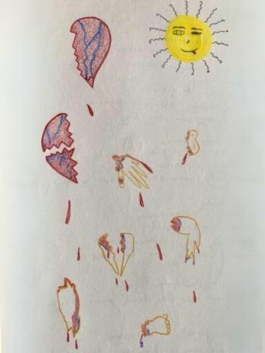
A small voice inside knocks and I choose to not ignore it: What harm is caused by having a fixed definition of ‘normal’? Who does that make visible? Invisible? How does that lend itself towards a hierarchy where better can exist? What violence does that engender? What does that do to contentment? Am I broken when not better? What if the ‘normal’ system is actually what’s broken?
You are welcome to answer these questions or add your own. Listen to your body answer, too.
For my graduate studies, I am focused on unfolding the healing industrial complex – a trillion dollar industry built upon the unrealistic and unreal universality of normal where anything outside of that standard needs to be bettered. It shows up as “alternative” medicine and “diversity” inclusion.
In a conversation between Resmaa Manakem, author of My Grandmother’s Hands, and Gabor Mate, author of The Myth of Normal, they remember to ask the questions often unasked – diverse from what? Alternative to what?
The culture we live in affects all of us; it is like the air we breathe. We aren’t free until we are all free, and right now, we are not free. It seems we need another approach to healing that doesn’t perpetuate the problem.
That is why, in my studies and life work, I am dedicated to other ways of knowing and being through dreamwork, the body, and the creative art process. These ways have been engaged with for time beyond time and are available to us each – we all dream, have bodies, and can engage with creativity.
A blessing: they bridge the gap between the individual’s story and our shared human condition. They get underneath appearances and the cognitive mind. They are wide enough to hold paradox. They remind and encourage us to be timeless and interconnected.
No one can take them away.
For the Love of Life and Death

In 2008, I was hospitalized for an intentional overdose. I lived in an inpatient treatment facility where I felt invisible. I became a statistic that had a treatment plan, which I had very little say in defining. Hardly was I asked questions; I was more so given orders and told what I could and couldn’t do.
Now I offer practices to which people come to relieve their pain. I can’t give them false hope or tell them lies to keep them in my classes. I ask them questions: what if you could feel better not by attempting to change yourself but by accepting yourself? And what if you changed through that acceptance?
As I teach I wonder how my students, and people in general, define better. Who gave them that definition? Where might they be without it?
And, most of all, I empathize. I aim to hold the complexity and paradox. I know what it is like to want to feel different. I also know that by practicing being with the direct experience of present-moment sensations in my body – be they what they are – I have grown leaps and bounds.
Through not trying to change myself, I have changed.
I’ll say this: change didn’t happen through pushing myself or my inner world away – although that was needed when it was needed.
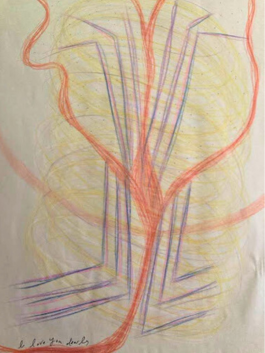
It was little moments – simple/complex moments felt for the multiplicity they contain. It was with the help of my dreams and art-making that held with me, lovingly and creatively, what was hard to hold. It was through relationships of all kinds. It was by noticing involuntary sighing, the precious exhale. It was with awareness and rerouting attention. It was through recognizing more than one thing is happening at once, all the time, and choosing what energy stream I follow. And it is still happening; it doesn’t end.
It was tough, and in some ways, only gets more difficult. The catch: my capacity to be with difficulty has increased tremendously. Difficulty has revealed itself to be certain sensations I denied – a very skilled survival strategy I wouldn’t ever condemn.
But now, I don’t have to spend so much time and effort trying to ensure that certain things don’t happen all the while trying to ensure that other things do. I can instead trust myself more and trust others to do what they do and be how they are.
“You can cover the world in leather or you can put on a pair of leather shoes.” my therapist said to me one day. What is your current approach?
What I’ve learned is healing is an ongoing process, a lot like love: it takes place through moment-to-moment heart postures. It is an unpredictable journey of transformation.
Dreams and the creative process have been unflinching lovers, embedding me in consciousness far greater than myself.
It is there – on the page and in the land of dreaming – where I exist honestly and am thoroughly known. And what emerges from this place? Love, creation, god dressed in drag, pain, fear, loneliness – a connection with the heart: the great heart, the universal heart, a holy space, and then a return to my unique expression of that heart.
Will you pause and notice you are breathing? Perhaps touch your heart, say thank you. Look away from the screen. Breathe in, and watch for the exhale.
Let me share the rest in a story – a story that through its writing and creative spirit, mirrored my authenticity while titrating it with imagery and metaphor – not much different than a dream. Through the writing, I was able to contextualize my narrative and link it with a more shared human predicament. There was room in the story for sense-making, play, and soul.
Babygirl and the HeartStone
(This is a shortened version of a much longer story. If you’d like to read it, reach out.)
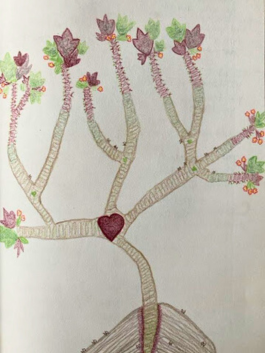
Babygirl was a sensitive child when she entered a world of giants where so many seemed to live in pain. She didn’t understand why pain was pervasive, but eventually, it scared her too. “What’s happening here?” She became disoriented.
In her confusion and heartbreak, she would run to the woods, past well-mowed grasses, past raspberry, dandelion, and plantain, until she was underneath the canopy of oak and maple. There, she would cry, she would pray, but she didn’t call it that; she didn’t need to. The great heart heard her every utterance and her unspoken everythings.
With her heart trembling, she would dig. Underneath the crisp brown leaves of autumn, the moist leaves of spring, the breaking down leaves of winter’s arrival. In the cold snow, the heavy snow, she would dig in search of something to steady her heart.
Stones. She found stones.
Every time her heart would tremble, she would pick up a stone – big stones, small stones, round stones, sharp stones; she loved them all. It didn’t appear to her that a house of stone was being constructed for her heart to live in. She just thought she was feeling better, making the tremble settle some.
There, in the house of stone, she lived for many years until her heart spoke; it had to, it couldn’t go on like this.
“Babygirl, I can barely breathe. Is there not another way?” She tried to find it. She had an idea, “I’ll make everything disappear! That will make it better.” But her heart wouldn’t agree. It wasn’t her time. That wasn’t the way.
Over the years, the great heart kept sending her dreams, kept reminding Babygirl of times that had come to pass. She recalled the forest; it was murmuring. “Come back, Babygirl…follow your heart, remember, remember…”
Off she went. “Hello? Is anyone there?” It was all but air for some time.
No one knows how much time passed before the stones began to speak. “Welcome home, Babygirl.
You picked up these stones long ago and you can put them down. But first…”
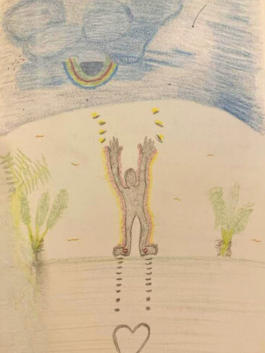
Thirteen consecutive nights passed where the stones wiggled; they shook, they trembled, they groaned, showing Babygirl images, memories of moments, cracking themselves apart from the mold they had formed. They knew she was ready.
She wept. She grunted. She sang. Sounds came out of her that she didn’t know existed. She doubted her capacity. They didn’t. They never did.
The day came when the whole house, stone by stone, broke free and fell apart. She looked up. The world outside, what she had been missing! A breath of fresh air, the moon tilted on her side, and a sigh from the heart.
She sang, “Now I know, I am never alone; everything around me is my home.” She sang to flowers, moss, rot, birds, stones, and water. The world listened. The seeds shook in rhythm.
She asked from the deepest part of her heart “Could it be so?” Everything was dancing and she knew it was so: The individual heart doesn’t exist. The heart connects all things. It is a force that joins together, lets go, and keeps going with the tides of life and death.
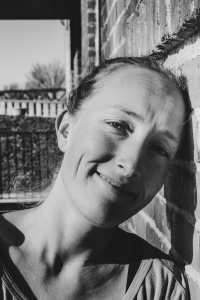
Julie MacAdam (she|they) is a somatic therapist and educator, teacher of Yasodhara Yoga, clinical herbalist, and dream tender who works one-on-one and with groups to support personal and collective evolution. There are many things she loves, here are a few: stones of all shapes and sizes, sunrises and sunsets, thanking the stars, dancing, free movement, breath, sighing, improvisational living and creating, dreaming, laughter and tears, serendipity, poetry, permission to not know, and practicing being human. You can find more about her here: myamountain.com
Artwork by Julie MacAdam
Resources I appreciate:
